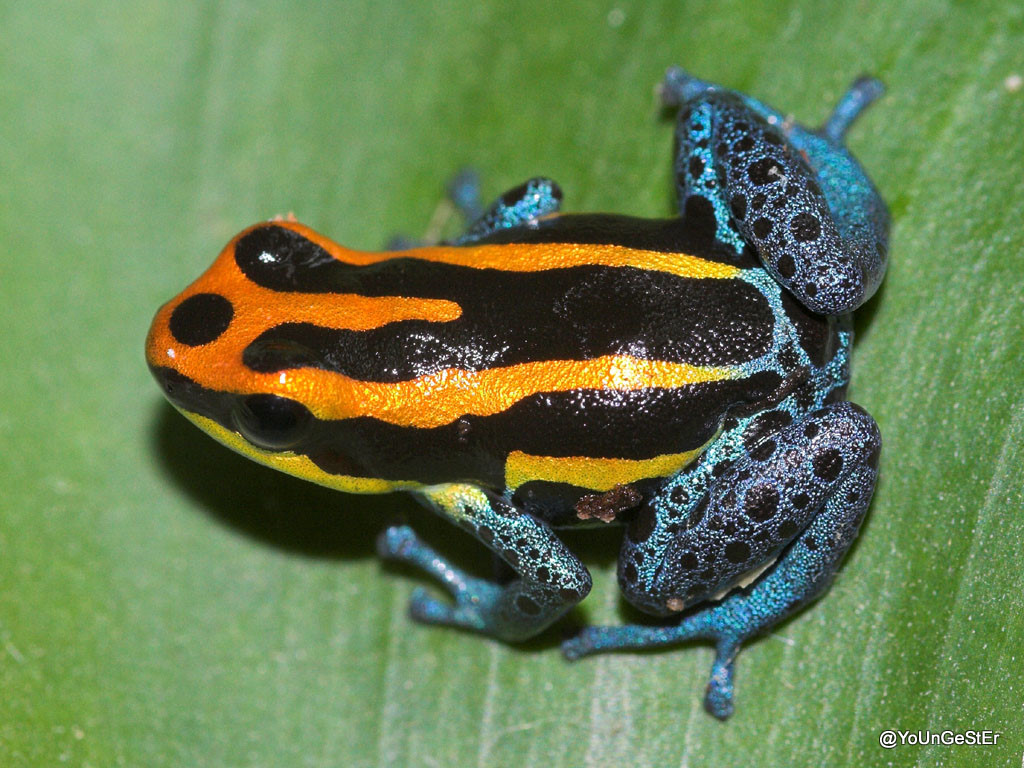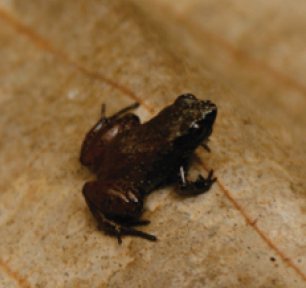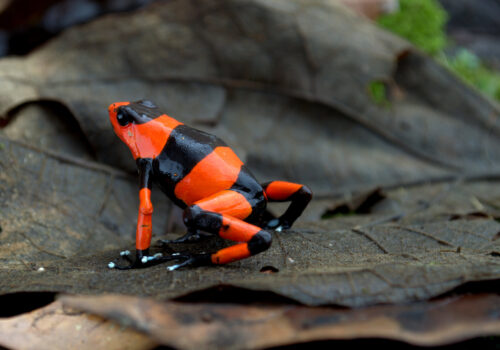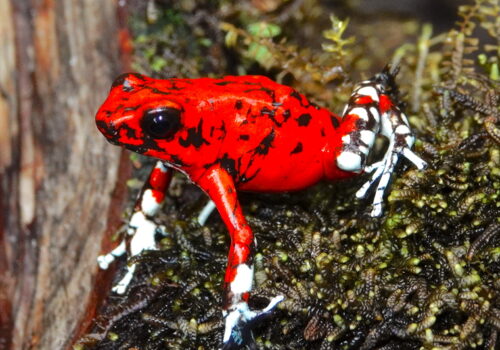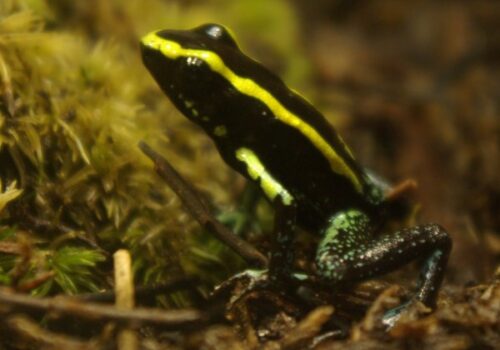- Jewels of the Rainforest: The Incredible Life of <em>Ranitomeya amazonica</em>
- Taxonomy and Classification
- Natural Habitat: A Jewel Among Leaves
- A Vivid Display: Physical Characteristics
- Behavior and Life Cycle: Guardians in Miniature
- A Keystone Role: The Ecological Significance of <em>Ranitomeya amazonica</em>
- Threats and Conservation Status: Small Frog, Major Challenges
- Cultural and Scientific Significance
- Conclusion: Preserving the Jewel of the Amazon
Jewels of the Rainforest: The Incredible Life of Ranitomeya amazonica#
Deep within the lush embrace of the Amazon rainforest, amid a mosaic of emerald canopies, twisting vines, and the steady hum of wildlife, lies a tiny creature glittering like a precious jewel. Ranitomeya amazonica, commonly known as the Amazonian Poison Dart Frog, is a miniature marvel cloaked in vibrant hues that captivate our eyes yet warn predators of hidden toxins. Although measuring barely more than a thumbnail, these dazzling amphibians are essential characters in the story of biodiversity and beauty woven intricately into Amazonia’s grand ecological tapestry.
Belonging to the family Dendrobatidae, poison dart frogs like Ranitomeya amazonica carry within their colorful exteriors remarkable biochemical secrets. These frogs have long fascinated researchers, nature enthusiasts, and indigenous peoples alike, serving as compelling ambassadors of the extraordinary biodiversity nurtured within tropical ecosystems. As we begin our immersive journey into their small yet extraordinary lives, let’s delve into the world of Ranitomeya amazonica, exploring how their habitat shapes their evolution, behavior, ecological significance, and why they urgently need our protection.
Taxonomy and Classification#
Ranitomeya amazonica occupies a definitive niche within amphibian biodiversity. As members of the family Dendrobatidae, known colloquially as poison dart frogs, they belong to the genus Ranitomeya, a group that epitomizes both the vibrancy and toxicity emblematic of tropical frogs. Originally described scientifically in 1999, R. amazonica was distinguished from closely related species thanks to an extensive census of their distinctive morphological patterns, genetic signatures, and nuanced behavioral attributes.
Within its genus, Ranitomeya amazonica shares ecological and evolutionary lineage with species like Ranitomeya reticulata and Ranitomeya ventrimaculata. Nonetheless, its distinctive appearance, calls, and geographic distribution confirm its unique niche and evolutionary path. Genetic studies suggest that subtle ecological pressures and intense selection promote incredible diversity among such closely related frogs, resulting in a kaleidoscope of colors and toxin variations.
Natural Habitat: A Jewel Among Leaves#
The range of Ranitomeya amazonica spans the greater Amazon Basin, predominantly inhabiting lowland forests in eastern Peru, western Brazil, southern Colombia, and northern Bolivia. Amid the labyrinthine understory, tangled vines, bromeliads, and shadowed leaf litter, these tiny frogs spend their entire lives within a few square meters of territory.
A Forest of Microhabitats#
When strolling beneath Amazonia’s dense canopy, one might overlook the intricate world at their feet. Yet, it is precisely here—hidden within pools of water captured by leaves, hollow tree cavities, and especially bromeliads—that R. amazonica thrives. Bromeliads, epiphytic plants abundant in rainforests, create miniature aquatic worlds above ground, providing ideal breeding grounds and nurseries for poison dart frogs. These “canopy ponds” buffer developing tadpoles from ground-level predators and offer nutrient-rich niches critical for their survival.
An Interaction Shaped by Survival#
The choice of habitat is far from coincidental. This precise microhabitat selection limits predator exposure, offers predictable prey sources (small arthropods like ants and mites), and provides critical moisture regulation essential for amphibian skin respiration. The survival of Ranitomeya amazonica is delicately balanced—each decision in habitat selection shapes their very existence and evolutionary adaptation.
A Vivid Display: Physical Characteristics#
No account of Ranitomeya amazonica can overlook their astonishing aesthetics. Beyond serving purely scientific fascination, their colorations serve crucial ecological functions. Adult frogs average only 12 to 18 millimeters in length—a reflection of their specialized lives adapted to very specific microenvironments. Despite their diminutive size, they are virtually impossible to overlook: their skin vibrantly displays intricate patterns of bright yellow, electric blue, fiery red, or crisp orange against a dramatic black background, an unmistakable warning advertisement known scientifically as aposematic coloration.
These patterns serve as evolutionary messages, signaling to predators the presence of potent alkaloid toxins lurking beneath their shiny skin. The toxins—derived from specialized diets rich in alkaloid-laden arthropods—evolve both as chemical defenses and for communication during mating and territorial disputes.
Behavior and Life Cycle: Guardians in Miniature#
The evolutionary dance of Ranitomeya amazonica continues beyond mere coloration. Much of their life revolves around carefully timed activities. Their days follow precise routines: hunting insects amid humid microclimates, warding off rivals with meticulously choreographed displays, and seeking optimal places to reproduce and carefully rear offspring.
Exquisite Family Care#
The breeding behaviors of Ranitomeya amazonica speak of remarkable adaptations. Males call rhythmically from selected sites within bromeliads or leaf-filled hollows to attract females. Upon meeting, a meticulous reproductive routine commences: the female deposits eggs, which are swiftly fertilized. Astonishingly, both parents demonstrate intricate care, protectorate roles that remain rare among amphibians. They check attentively on the clutch, and when eggs hatch, parental responsibility continues in remarkable fashion.
In a wondrous feat of nature, parents transport newly hatched tadpoles delicately on their backs, each placed individually into carefully chosen bromeliad pools. Regularly, females traverse pathways amid dense vegetation, returning to each pool with nutrient-rich, unfertilized “food” eggs to nourish their young. Their care extends through metamorphosis, witnessing the tiny offspring transform from aquatic tadpole to miniature terrestrial danger signal—a microcosmic portrayal of profound parental devotion.
A Keystone Role: The Ecological Significance of Ranitomeya amazonica#
Despite their size, poison dart frogs play outsized roles. As predators, they regulate minute arthropod populations, influencing entire insect communities. Simultaneously, they form integral links within food chains, serving as indicators of ecosystem health. Their sensitivity to pollution and climatic variation highlights broader environmental changes before human observers detect them.
By supporting plant reproduction through their interactions with bromeliads and insects, Ranitomeya amazonica demonstrates that ecosystem dynamics always operate beyond visible scales, interweaving diverse biological threads into a cohesive ecological narrative.
Threats and Conservation Status: Small Frog, Major Challenges#
Though hardy within their habitats, Ranitomeya amazonica faces external pressures that jeopardize its stellar beauty and ecological role. Expanding agricultural ventures, rampant illegal logging, and habitat fragmentation gradually erode their specialized microhabitats, risking local extinctions. Furthermore, illicit collection for pet trade remains a persistent threat.
A Call for Urgent Action#
The International Union for Conservation of Nature (IUCN) classifies Ranitomeya amazonica as Least Concern, yet highlights increased vulnerability due to habitat loss. Effective conservation thus demands proactive habitat protection, sustainable ecotourism, community-driven education, and rigorous enforcement against illegal collection. These efforts depend greatly on raising local and international awareness, fostering appreciation for the jewels hidden amid rainforest foliage.
Cultural and Scientific Significance#
The Amazonian Poison Dart Frog garners historical recognition among indigenous communities, symbolizing hidden strength and intricate ecological knowledge. Scientific breakthroughs further amplify their importance as research targets—studies into their toxins offer biomedical advances, potentially contributing to drug discoveries combating pain and disease.
Conclusion: Preserving the Jewel of the Amazon#
Ranitomeya amazonica exemplifies the wonder of evolutionary adaptation, ecological interconnectedness, and environmental fragility that define tropical forests. As caretakers of our planet’s biodiversity, we carry responsibilities to safeguard these remarkable amphibians and their habitats. By championing conservation, promoting sustainable lifestyles, supporting ecologically responsible initiatives, and cultivating genuine appreciation for life’s intricate diversity, we secure not only the future of vibrant frogs like Ranitomeya amazonica but the very essence of Earth’s lush, life-giving rainforests.
Let us honor their beauty and significance by lending our voices and choices to meaningful change. In doing so, we prove ourselves worthy stewards of nature’s most dazzling treasures.


